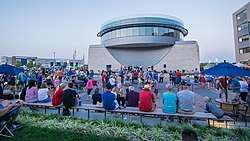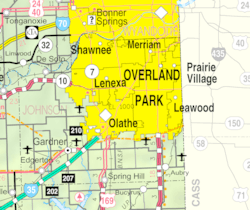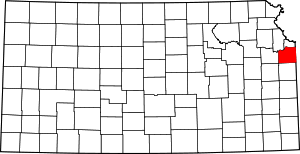Lenexa, Kansas
Lenexa /lɪˈnɛksə/ is a city in Johnson County, Kansas, United States. It is the 8th most populated city in the Kansas City Metropolitan Area.[6] As of the 2010 census, the population was 48,190 with a 2019 estimate of 55,625; growing by 15.4%.[7][8] It is the birthplace of Garmin, the regional headquarters of Kiewit Construction and the former headquarters of Applebee’s[9][10][11] It is bordered by the cities of Shawnee to the north, Overland Park to the east, De Soto to the west and Olathe to the south.
Lenexa, Kansas | |
|---|---|
 Lenexa City Center (2017) | |
 Location within Johnson County and Kansas | |
 KDOT map of Johnson County (legend) | |
| Coordinates: 38°57′53″N 94°45′34″W | |
| Country | United States |
| State | Kansas |
| County | Johnson |
| Incorporated | 1907 |
| Government | |
| • Mayor | Michael Boehm |
| • City Manager | Beccy Yocham |
| Area | |
| • Total | 34.39 sq mi (89.08 km2) |
| • Land | 34.07 sq mi (88.24 km2) |
| • Water | 0.32 sq mi (0.83 km2) 1.02% |
| Elevation | 1,033 ft (315 m) |
| Population | |
| • Total | 48,190 |
| • Estimate (2019)[3] | 55,625 |
| • Density | 1,632.57/sq mi (630.35/km2) |
| Time zone | UTC-6 (CST) |
| • Summer (DST) | UTC-5 (CDT) |
| ZIP codes | 66200-66299 |
| Area code | 913 |
| FIPS code | 20-39350 [4] |
| GNIS ID | 0479208 [5] |
| Website | lenexa.com |
History
Twelve years before the town of Lenexa was platted, James Butler Hickok staked a claim on 160 acres (65 ha) at what is now the corner of 83rd and Clare Road.[12] Filed in 1857, the claim was not far from the Kansas River, and was 20 miles (32 km) southwest of Westport, Missouri, and the start of the Santa Fe Trail. The trail meandered through this area on its way to Santa Fe, New Mexico.
On March 22, 1858, Hickok was elected one of the first four constables of nearby Monticello Township. Later, Hickok became a scout for the Free-State Army, a sharpshooter and eventually, one of the most famous folk heroes of the American West, Wild Bill Hickok.
At about the same time as Hickok filed his claim, a census of the Shawnee Indians living in the area was being taken, and one of the residents listed was Na-Nex-Se Blackhoof. She was the widow of Chief Blackhoof, the second signer of the 1854 treaty that ceded 1,600,000 acres (650,000 ha) of the Kansas Shawnee Indian reservation to the United States government.
In 1865, the Kansas and Neosho Valley Railroad was organized to take advantage of favorable new land laws. It later changed its name to Missouri River, Ft. Scott and Gulf Railroad, and in 1869 purchased a right-of-way from C.A. Bradshaw in the area that is now Lenexa, with the stipulation that a depot be built on the property.
Bradshaw also sold 10.5 acres (4.2 ha) to Octave Chanute, a railroad civil engineer, who platted the town in 1869. Legend states that the first town name proposed was "Bradshaw", but Bradshaw modestly refused and the name "Lenexa", a derivation of the name Na-Nex-Se, the name of Shawnee Chief Thomas Blackhoof's wife, was adopted.
Geography
Lenexa is located at 38°57′53″N 94°45′34″W (38.964689, -94.759535).[13] According to the United States Census Bureau, the city has a total area of 34.45 square miles (89.23 km2), of which, 34.10 square miles (88.32 km2) is land and 0.35 square miles (0.91 km2) is water.[14]
Demographics
| Historical population | |||
|---|---|---|---|
| Census | Pop. | %± | |
| 1910 | 583 | — | |
| 1920 | 472 | −19.0% | |
| 1930 | 452 | −4.2% | |
| 1940 | 502 | 11.1% | |
| 1950 | 803 | 60.0% | |
| 1960 | 2,497 | 211.0% | |
| 1970 | 5,242 | 109.9% | |
| 1980 | 18,639 | 255.6% | |
| 1990 | 34,034 | 82.6% | |
| 2000 | 40,238 | 18.2% | |
| 2010 | 48,190 | 19.8% | |
| Est. 2019 | 55,625 | [3] | 15.4% |
| U.S. Decennial Census[15] | |||
The median income for a household was $61,990, and the median income for a family was $76,321 (these figures had risen to $70,246 and $86,581 respectively as of a 2007 estimate). Males had a median income of $50,495 versus $32,166 for females. The per capita income for the city was $30,212. About 1.8% of families and 3.4% of the population were below the poverty line, including 2.9% of those under age 18 and 3.0% of those age 65 or over.
2010 census
As of the census[2] of 2010, there were 48,190 people, 19,288 households, and 13,065 families living in the city. The population density was 1,413.2 inhabitants per square mile (545.6/km2). There were 20,832 housing units at an average density of 610.9 per square mile (235.9/km2). The racial makeup of the city was 84.4% White, 5.8% African American, 0.4% Native American, 3.8% Asian, 0.1% Pacific Islander, 3.0% from other races, and 2.5% from two or more races. Hispanic or Latino of any race were 7.3% of the population.
There were 19,288 households of which 33.7% had children under the age of 18 living with them, 55.3% were married couples living together, 9.0% had a female householder with no husband present, 3.4% had a male householder with no wife present, and 32.3% were non-families. 25.2% of all households were made up of individuals and 7.3% had someone living alone who was 65 years of age or older. The average household size was 2.48 and the average family size was 3.00.
The median age in the city was 36.6 years. 24.7% of residents were under the age of 18; 8.3% were between the ages of 18 and 24; 28.2% were from 25 to 44; 28.5% were from 45 to 64; and 10.3% were 65 years of age or older. The gender makeup of the city was 48.7% male and 51.3% female.
2000 census
As of the U.S. Census in 2000,[4] there were 40,238 people, 15,574 households, and 10,559 families living in the city. The population density was 1,173.8 people per square mile (453.2/km2). There were 16,378 housing units at an average density of 477.8 per square mile (184.5/km2). The racial makeup of the city was 89.50% White, 6.50% Black or African American, 0.38% Native American, 3.63% Asian, 0.03% Pacific Islander, 1.60% from other races, and 1.61% two or more races. Hispanic or Latino of any race were 3.97% of the population. 24.8% were of German, 12.4% English, 12.1% Irish and 7.2% American ancestry.
There were 15,574 households out of which 35.1% had children under the age of 18 living with them, 57.4% were married couples living together, 7.6% had a female householder with no husband present, and 32.2% were non-families. 24.3% of all households were made up of individuals and 5.8% had someone living alone who was 65 years of age or older. The average household size was 2.54 and the average family size was 3.08.
In the city, the population was spread out with 25.7% under the age of 18, 9.5% from 18 to 24, 32.0% from 25 to 44, 24.2% from 45 to 64, and 8.6% who were 65 years of age or older. The median age was 35 years. For every 100 females, there were 95.8 males. For every 100 females age 18 and over, there were 93.1 males.
Economy
Garmin was founded in Lenexa [9]
Largest employers
According to the City's 2015 Comprehensive Annual Financial Report,[16] the largest employers in the city are:
| # | Employer | # of Employees |
|---|---|---|
| 1 | United Parcel Service | 2,087 |
| 2 | Quest Diagnostics/Lab One | 1,954 |
| 3 | Kiewit Power Engineers Company | 1,292 |
| 4 | JC Penney Logistics Center | 1,200 |
| 5 | Alliance Data Systems | 730 |
| 6 | Gear for Sports | 600 |
| 7 | Lakeview Village | 586 |
| 8 | Lexmark | 570 |
| 9 | Clinical Reference Lab | 567 |
| 10 | PRA International | 560 |
Government
Lenexa is the home of a Records Center managed by the National Archives and Records Administration. The facility stores federal records from agencies in Iowa, Kansas, Missouri, and Nebraska including Department of Veterans Affairs and the Internal Revenue Service.[17] The facility is also known informally as "The Caves" and is known to store items from the trauma room at Parkland Memorial Hospital in Dallas, Texas, where John F. Kennedy was pronounced dead following his assassination.[18] As of January 2020, the current Mayor of Lenexa is Michael Boehm and the current City Manager is Beccy Yocham.[19][20]
Education
Lenexa does not have a public school district of its own. Instead, Lenexa students go to either Shawnee Mission School District, Olathe School District, or De Soto School District schools. It is also home to a handful of private schools. Lenexa's first private high school, St. James Academy, opened in 2005. The Johnson County Library had a branch in Lenexa, the Lackman Library. Wichita based Friends University also has a branch in Lenexa, as does Brown Mackie College. The International Assembly for Collegiate Business Education is based in Lenexa; its competitive peer, the Accreditation Council for Business Schools and Programs, is based in neighboring Overland Park.
Culture
Events
Each June the city hosts "The Great Lenexa Barbecue Battle", which is also the Kansas State Championship. Lenexa was known as the "Spinach Capital of the World"[21] in the 1930s and celebrates with the Spinach Festival every September.
Religion
Lenexa is home to the St. George Serbian Orthodox Church, a parish founded in Kansas City in 1906 and moved to Lenexa in 2006. The parish constructed a new Byzantine style church and cultural center. The church hosts a SerbFest every year in the summer and a Food Festival and Bazaar in the fall.
Notable people
Notable individuals who were born in and/or have lived in Lenexa include:
- Warren Ault (1887-1989), historian[22]
- Cam F. Awesome (1988- ), boxer[23]
- Madison Desch (1997- ), gymnast[24]
- Drake Dunsmore (1988- ), football tight end[25]
- Wild Bill Hickok (1837-1876), gunfighter. He staked a claim on 160 acres (0.65 km2) at what is now the corner of 83rd and Clare Road.[12] He worked as a stocktender at the nearby Reed Hotel and later was elected constable of Monticello Township. A park in his name is now in that area.
- Lucas Rodríguez (1986- ), soccer midfielder[26]
- William Shaw (1955- ), biochemist, autism researcher[27]
- Jason Wiles (1970- ), actor, director, producer.[28] Starred as Maurice 'Bosco' Boscorelli (1999–2005) in the television series Third Watch.
- Ron Worley (1945- ), Kansas state legislator[29]
- Baron Corbin (1984- ), WWE Wrestler[30]
- Grace VanderWaal (2004- ), winner of the eleventh season of the NBC TV competition show America's Got Talent[31]
See also
References
- "2019 U.S. Gazetteer Files". United States Census Bureau. Retrieved July 24, 2020.
- "U.S. Census website". United States Census Bureau. Retrieved 2012-07-06.
- "Population and Housing Unit Estimates". United States Census Bureau. May 24, 2020. Retrieved May 27, 2020.
- "U.S. Census website". United States Census Bureau. Retrieved 2008-01-31.
- "US Board on Geographic Names". United States Geological Survey. 2007-10-25. Retrieved 2008-01-31.
- https://www.census.gov/quickfacts/lenexacitykansas
- "2010 City Population and Housing Occupancy Status". U.S. Census Bureau. Retrieved March 6, 2011.
- "Garmin". Companieshistory.com. 15 January 2014. Retrieved 24 June 2019.
- "Applebee's Celebrates Grand Opening of Its New Headquarters in Lenexa". Investors.dineequity.com. Retrieved 24 June 2019.
- ""The Lenexa Police Department History"". Archived from the original on 2009-06-24. Retrieved 2009-06-24.CS1 maint: BOT: original-url status unknown (link).
- "US Gazetteer files: 2010, 2000, and 1990". United States Census Bureau. 2011-02-12. Retrieved 2011-04-23.
- "US Gazetteer files 2010". United States Census Bureau. Archived from the original on 2012-07-02. Retrieved 2012-07-06.
- United States Census Bureau. "Census of Population and Housing". Retrieved November 29, 2014.
- "Wayback Machine" (PDF). 28 February 2017. Archived from the original (PDF) on 28 February 2017. Retrieved 24 June 2019.
- "The National Archives in Lenexa, Kansas". National Archives. Archived from the original on 2009-12-17. Retrieved 20 November 2009.
- Keen, Judy (November 20, 2009). "JFK Relics Stir Strong Emotions". USA Today. Retrieved 20 November 2009.
- "Mayor Michael Boehm - City of Lenexa". City of Lenexa. Retrieved January 21, 2020.
- "City Manager's Office - City of Lenexa". City of Lenexa. Retrieved January 21, 2020.
- Brackman, Barbara (1997). Kansas Trivia. Thomas Nelson Inc. p. 10.
- "Warren Ault dies; Baker grad was oldest Rhodes scholar". The Lawrence Journal-World. 1989-05-15. Retrieved 2016-03-25.
- Grathoff, Pete (2015-07-24). "After losing bout, Lenexa's Cam F. Awesome says he's been called the Taylor Swift of boxing". The Kansas City Star. Retrieved 2016-03-25.
- "Madison Desch". USA Gymnastics. Retrieved 2016-03-25.
- "Drake Dunsmore". NU Sports. Retrieved 2016-03-25.
- "Midfielder Lucas Rodriguez Returns to Comets for 2015/16 MASL Season". Our Sports Central. Retrieved 2016-03-25.
- Tsouderos, Trine; Callahan, Patricia (2009-12-07). "Chelation based on faulty premise". Los Angeles Times. Retrieved 2016-03-25.
- "Jason Wiles". IMDb. Retrieved 2016-03-25.
- "Ron Worley's Biography". Vote Smart. Retrieved 2016-03-25.
- "Behind WWE superstar villain Baron Corbin is an ornery, edgy Lenexa native". Kansascity.com. Retrieved 23 November 2016.
- "America's Got Talent 11th Season Contestants". Retrieved 2 December 2016.
Further reading
External links
| Wikimedia Commons has media related to Lenexa, Kansas. |
- City
- Schools
- Maps
- Lenexa City Map, KDOT

